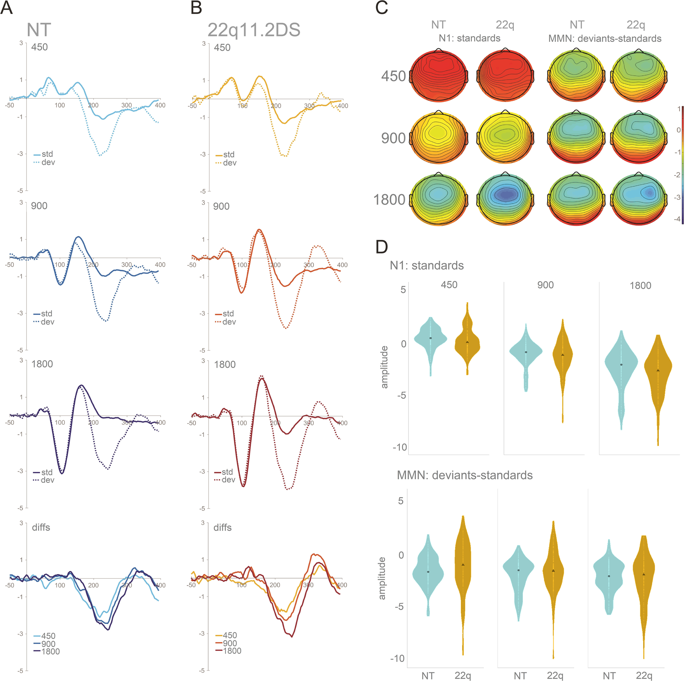Translational Psychiatry ( IF 5.8 ) Pub Date : 2020-03-05 , DOI: 10.1038/s41398-020-0764-3 Ana A Francisco 1, 2 , John J Foxe 1, 2, 3 , Douwe J Horsthuis 1 , Danielle DeMaio 1 , Sophie Molholm 1, 2, 3

|
22q11.2 Deletion Syndrome (22q11.2DS) is the strongest known molecular risk factor for schizophrenia. Brain responses to auditory stimuli have been studied extensively in schizophrenia and described as potential biomarkers of vulnerability to psychosis. We sought to understand whether these responses might aid in differentiating individuals with 22q11.2DS as a function of psychotic symptoms, and ultimately serve as signals of risk for schizophrenia. A duration oddball paradigm and high-density electrophysiology were used to test auditory processing in 26 individuals with 22q11.2DS (13–35 years old, 17 females) with varying degrees of psychotic symptomatology and in 26 age- and sex-matched neurotypical controls (NT). Presentation rate varied across three levels, to examine the effect of increasing demands on memory and the integrity of sensory adaptation. We tested whether N1 and mismatch negativity (MMN), typically reduced in schizophrenia, related to clinical/cognitive measures, and how they were affected by presentation rate. N1 adaptation effects interacted with psychotic symptomatology: Compared to an NT group, individuals with 22q11.2DS but no psychotic symptomatology presented larger adaptation effects, whereas those with psychotic symptomatology presented smaller effects. In contrast, individuals with 22q11.2DS showed increased effects of presentation rate on MMN amplitude, regardless of the presence of symptoms. While IQ and working memory were lower in the 22q11.2DS group, these measures did not correlate with the electrophysiological data. These findings suggest the presence of two distinct mechanisms: One intrinsic to 22q11.2DS resulting in increased N1 and MMN responses; another related to psychosis leading to a decreased N1 response.
中文翻译:

评估 22q11.2 缺失综合征个体与精神分裂症相关的听觉处理内表型。
22q11.2 缺失综合征 (22q11.2DS) 是已知最强的精神分裂症分子危险因素。大脑对听觉刺激的反应已在精神分裂症中得到广泛研究,并被描述为易患精神病的潜在生物标志物。我们试图了解这些反应是否可能有助于区分 22q11.2DS 个体作为精神病症状的函数,并最终作为精神分裂症风险的信号。使用持续时间奇怪范式和高密度电生理学来测试 26 名 22q11.2DS 个体(13-35 岁,17 名女性)的听觉处理,这些个体具有不同程度的精神病症状,以及 26 名年龄和性别匹配的神经典型对照(新界)。呈现速率在三个级别上有所不同,以检查记忆需求增加和感觉适应完整性的影响。我们测试了 N1 和错配负性(MMN)(通常在精神分裂症中减少)是否与临床/认知测量相关,以及它们如何受到就诊率的影响。N1 适应效应与精神病症状相互作用:与 NT 组相比,具有 22q11.2DS 但无精神病症状的个体表现出较大的适应效应,而具有精神病症状的个体则表现出较小的影响。相比之下,患有 22q11.2DS 的个体无论是否存在症状,都表现出呈现率对 MMN 振幅的影响增加。虽然 22q11.2DS 组的智商和工作记忆较低,但这些测量结果与电生理数据无关。这些发现表明存在两种不同的机制:一种是 22q11.2DS 固有的,导致 N1 和 MMN 反应增加;另一种是 22q11.2DS 固有的,导致 N1 和 MMN 反应增加。另一种与导致 N1 反应降低的精神病有关。











































 京公网安备 11010802027423号
京公网安备 11010802027423号